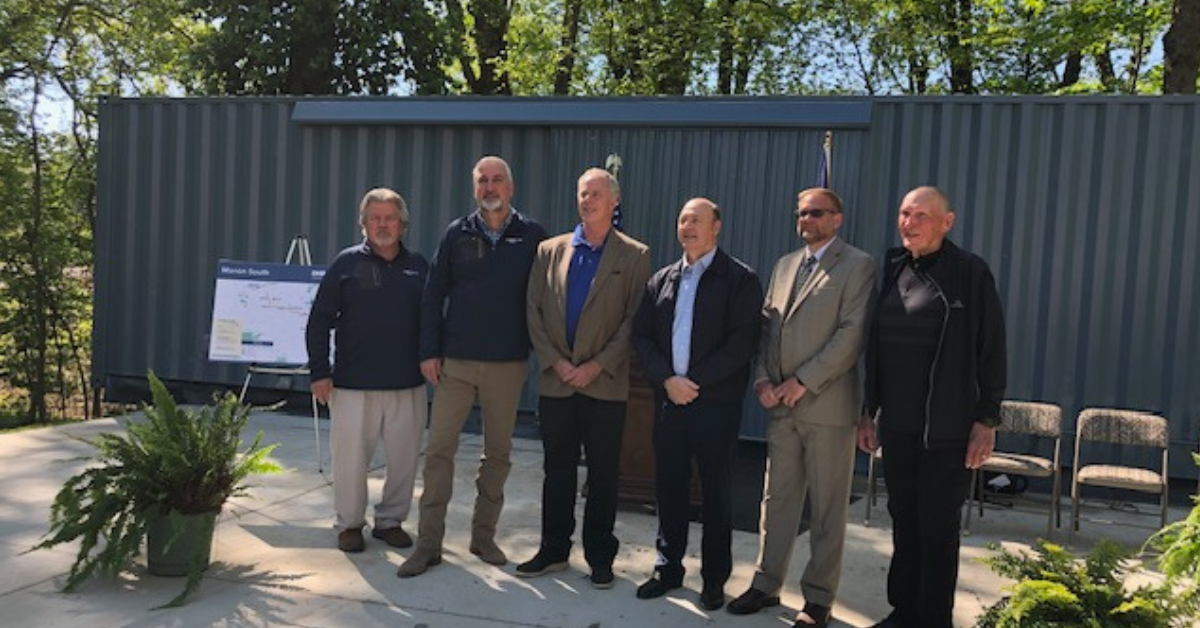Carol Johnson, Southern Indiana Business Report
SALEM – With a section of the future Monon South trail just a few yards behind him, Indiana Gov. Eric Holcomb led a celebration of what will become Indiana’s longest recreational trail in southern Indiana Friday.
Coming in at 62.3 miles, the Monon South will follow the route of the historic Monon Railroad through five counties. Beginning in New Albany, the trail will run through Borden, Salem, Campbellsburg, Saltillo, Orleans and Mitchell.
The state’s Next Level Trails program provided $29.5 million to design and construct the trail.
“Outdoor amenities play a huge part in where people want to live and where they work. Trails connecting communities – urban, suburban, rural – allow Indiana to showcase all we have to offer on one trail,”Holcomb said.
The celebration was held in an amphitheater adjacent to the Depot Railroad Museum and John Hay Center in Salem. About 50 people attended the event.
Calling it a proud moment, Holcomb said the trail is symbolic of the state’s reputation as a trailblazer, going back to before it was an official state. Under Holcomb’s leadership, the state has invested about $150 million in 75 trail projects.
“This is in our DNA, but it all comes back to communities coming together. A day like today proves to me that when you think locally, regionally and statewide, this is the impact you can have when all the stars align,” he said.
The section between New Albany and Salem will put 440,000 people within 10 miles of a trail. Holcomb said his goal is to have every Hoosier living within 5 miles of a trail.
In closing, Holcomb thanked the DNR staff, DNR Director Dan Bortner, New Albany Mayor Jeff Gahan, Salem Mayor Justin Green, Radius Indiana President and CEO Jeff Quyle, Cook Group Chairman Steve Ferguson, CSX and trail advocates for pushing for the Monon South.
With rail removal underway, Quyle outlined the next steps for the trail.
“We will prioritize design and construction to deliver maximum value to the citizens along the trail as quickly as possible,” he said.
Southern Indiana Trailways, a private nonprofit, will grow into the steward of the Monon South. This summer there will be public meetings to share information with communities and to gather information from the public to help prepare a plan for construction.
It’s anticipated there will be construction of paved trail segments before the end of 2024. Plans also call for improving safety at road crossings in collaboration with county governments. In 2025-26, construction will focus on rural sections of the trail. Radius will create a toolbox of assistance for business growth in communities along the Monon South.
“A trail like the Monon South is a powerful tool for economic growth,” Quyle said. “That’s why Radius, an economic development organization, is pleased to put our heart and soul into making the Monon South an anchor for business growth, community health and tourism attraction.”
Salem Mayor Justin Green said the trail represents an investment in quality of place that people of all ages can enjoy to experience nature or improve their health.
“This is generational, everybody gets to use this,” he said.
Ferguson praised the work of Holcomb, DNR, the mayors and Radius for stepping up to develop the trail.
“It’s a tremendous responsibility to take this where it needs to be,” he added, referring to Quyle and Radius.
Besides the benefits to residents, Ferguson said the creation of a 62-mile recreational trail sends a positive message to outside developers for investing in quality of place.
“The significance of this can’t be overstated,” he said.
Ferguson also pointed to the history of the Monon, and not to forget the personal histories of the many people who worked for the Monon or traveled its lines. People like Rick Dreistadt, who worked for Monon Railroad for 44 years, retiring in 2016 as a relief agent, drove from his home in Crandall, north of Corydon, for the event.
He said he didn’t mind that a trail is going to be where the rail line used to be.
“I hated to see it go,” Dreistadt said. “Other than seeing trains go by again, I think this is the second best option.”
A 62-mile trail that connects rural and urban centers is sure to become a destination trail, said Eric Oberg, Midwest region Director of the Rails to Trails Conservancy.
“A trail like this is very unique, it’s the kind of trail that is on bucket lists.”



